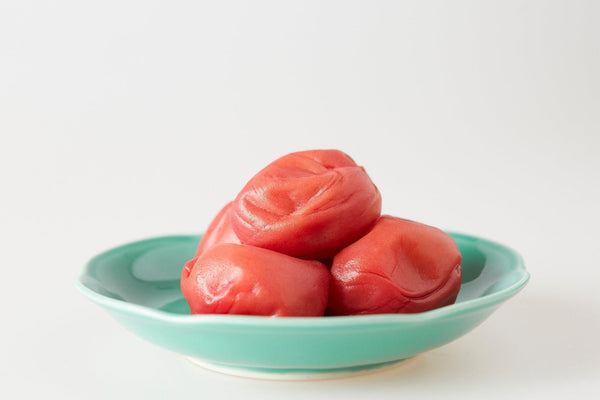
Jump to:
What is Umeboshi?
Umeboshi is a type of Japanese pickled plum. It is typically consumed during the wintertime and is said to be an immunity booster. The pickling process involves salt-drying and then adding vinegar for preservation for at least three months. The salt slows the aging process and naturally preserves the fruit, while the vinegar balances the sour flavor of umeboshi. During the fermentation process, red shiso leaves are also added to give the umeboshi their pink color.
Umeboshi can be used in many dishes such as vinaigrettes, salad dressings, noodles, sandwiches, and rice balls. A common way of eating it is to enjoy it with rice along with other side dishes like fish or meat, or vegetables like cucumbers and carrots. Umeboshi that has been preserved in salt can last up to one year without refrigeration, stored at room temperature.

What does Umeboshi taste like?
Umeboshi has a strong and intense flavor – adding an instant umami kick to any dish. Due to its high content of citric acid, umeboshi tastes very sour, tangy, and salty, so it can be considered somewhat of an acquired taste, especially if you are not used to eating them.

Health benefits of umeboshi
Umeboshi is considered a superfood in Japanese cuisine and has been used for medicinal purposes for hundreds of years. It is believed that they were used by Japanese samurai when going into battle to help cure illnesses, and with recovery from food poisoning.
These days umeboshi is also widely used as a hangover cure. The high content of citric acid helps aid digestion, stimulating the liver to create a detoxifying effect on the body. To make a hangover cure tea, add one umeboshi to hot water for five minutes the drink the tea and eat the umeboshi together. You can also try sucking on an umeboshi plum after a night of drinking before you go to bed!
The tart taste of Umeboshi stimulates appetite, aids digestion, and helps with bloating. The citric acid in the plums also helps to break down the foods eaten with it by reducing their alkalinity. This stimulates gastric juices that help digestion and absorption of nutrients from food.
Umeboshi also contains essential vitamins such as vitamins A, C, B1, B2, E and K as well as minerals such as iron, copper and zinc which all contribute to your overall health.
How do you eat umeboshi?
You may be wondering how umeboshi are used within Japanese cuisine. Umeboshi is quite versatile and can be eaten whole, ground into paste, or in vinegar. Here are six suggestions of different ways you can use umeboshi in your cooking:
Onigiri – these are Japanese rice balls that are usually triangular or circular in shape. Filling and easy to make, they are a popular Japanese food and can be found in every convenience store in Japan. Onigiri are made from white rice and are often wrapped in nori seaweed. As white rice can taste rather bland by itself, umeboshi is a popular onigiri filling, providing a rich savory, and tangy flavor.

Bento boxes – Japanese bento boxes often include a small umeboshi placed on top of white steamed rice. This tradition known as “hinomaru bento” is supposed to resemble the red circle of the sun as found on the Japanese flag.

Ochazuke – this traditional and simple Japanese dish consists of steamed white rice and various toppings partially steeped in green tea or dashi broth to create a comforting and filling meal. Umeboshi can be added as a topping in addition to other savory ingredients like nori seaweed, salmon flakes, or fish roe.

Tempura – create crispy umeboshi tempura by coating umeboshi in tempura batter made from flour, egg, and iced water and deep-frying in vegetable oil until golden.

Umeboshi dressings and marinades – try adding umeboshi paste to marinades for grilled meats mixed with other ingredients like soy sauce, ginger, and lime. You can also make a quick dressing from umeboshi paste, vinegar, vegetable oil, soy sauce, and sugar to serve with green vegetables and grilled fish.

Umeboshi mayo – mix umeboshi plums with mayonnaise to create a delicious tangy mayonnaise perfect for accompanying dishes like yakitori and sushi.

Umeboshi in Vegan cuisine
Umeboshi is also a popular ingredient used in many vegan dishes when added to vinegar, thanks to the umami flavor it gives to salad dressings, marinades, and stir-fried vegetables.
Because umeboshi is also high in iron and potassium which are key minerals for our bodies, this makes them perfect for vegetarians and vegans who limit their diet to only plant-based food items.
Where can I buy umeboshi?
You can often find umeboshi in health food stores and Japanese supermarkets. Japanese Taste also has a range of unique umeboshi products you can order directly from Japan in addition to the plums themselves, such as umeboshi vinegar which can be used as a base for salad dressings or sauces, and umeboshi sour candy.
How to make umeboshi at home
If you prefer to try making umeboshi yourself rather than buying it ready-made, there are plenty of easy-to-follow recipes online you can try! Our favorites include this recipe from Just One Cookbook which recommends starting the process in mid-June when ripened ume fruit first starts to appear in stores. Pickled ume needs to be dried under the sun for three days so it’s best to make it during the summertime.



0 comments